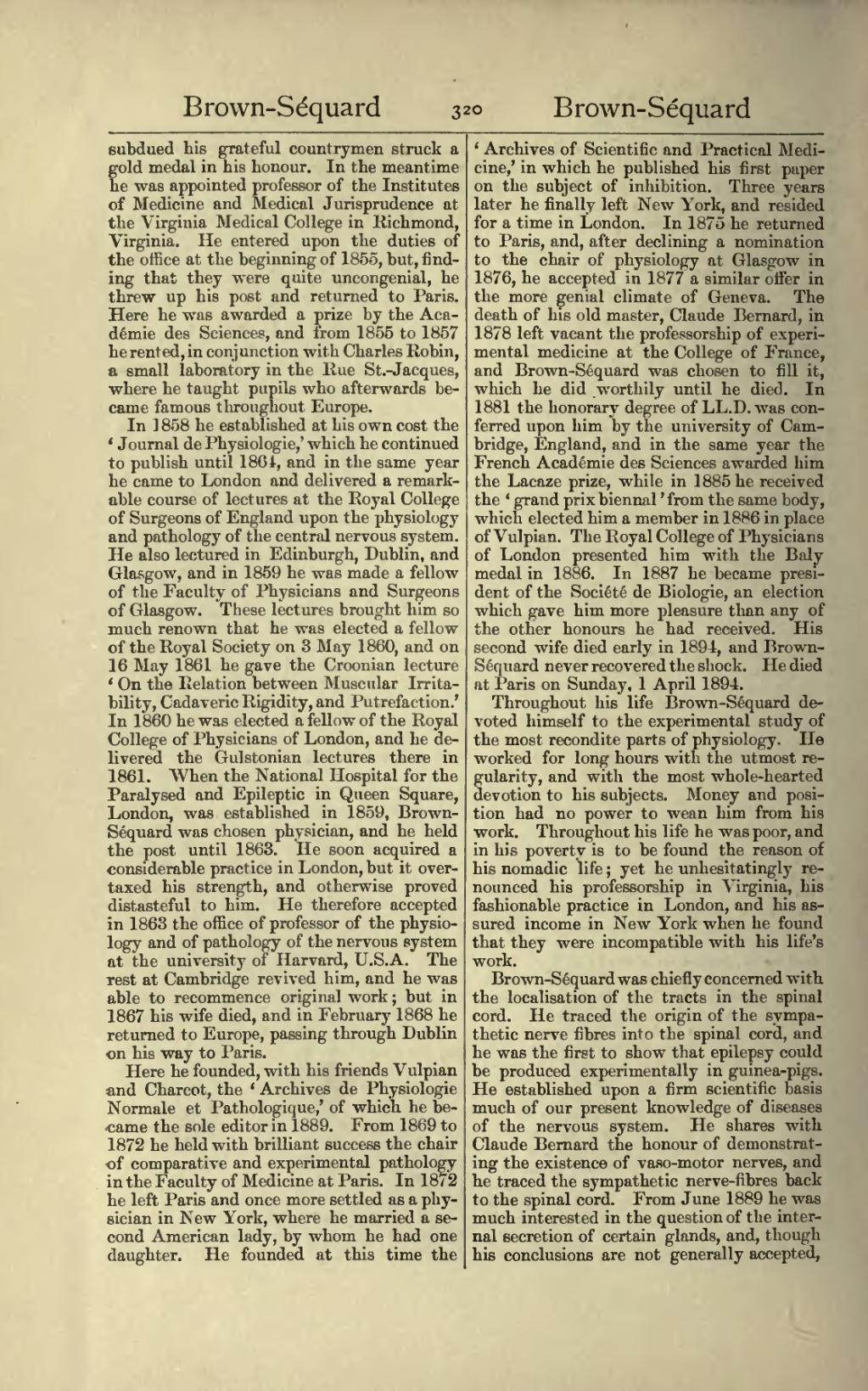subdued his grateful countrymen struck a gold medal in his honour. In the meantime he was appointed professor of the Institutes of Medicine and Medical Jurisprudence at the Virginia Medical College in Richmond, Virginia. He entered upon the duties of the office at the beginning of 1855, but, finding that they were quite uncongenial, he threw up his post and returned to Paris. Here he was awarded a prize by the Académie des Sciences, and from 1855 to 1857 he rented, in conjunction with Charles Robin, a small laboratory in the Rue St.-Jacques, where he taught pupils who afterwards became famous throughout Europe.
In 1858 he established at his own cost the 'Journal de Physiologie,' which he continued to publish until 1864, and in the same year he came to London and delivered a remarkable course of lectures at the Royal College of Surgeons of England upon the physiology and pathology of the central nervous system. He also lectured in Edinburgh, Dublin, and Glasgow, and in 1859 he was made a fellow of the Faculty of Physicians and Surgeons of Glasgow. These lectures brought him so much renown that he was elected a fellow of the Royal Society on 3 May 1860, and on 16 May 1861 he gave the Croonian lecture 'On the Relation between Muscular Irritability, Cadaveric Rigidity, and Putrefaction.' In 1860 he was elected a fellow of the Royal College of Physicians of London, and he delivered the Gulstonian lectures there in 1861. When the National Hospital for the Paralysed and Epileptic in Queen Square, London, was established in 1859, Brown-Séquard was chosen physician, and he held the post until 1863. He soon acquired a considerable practice in London, but it over-taxed his strength, and otherwise proved distasteful to him. He therefore accepted in 1863 the office of professor of the physiology and of pathology of the nervous system at the university of Harvard, U.S.A. The rest at Cambridge revived him, and he was able to recommence original work; but in 1867 his wife died, and in February 1868 he returned to Europe, passing through Dublin on his way to Paris.
Here he founded, with his friends Vulpian and Charcot, the 'Archives de Physiologie Normale et Pathologique,' of which he became the sole editor in 1889. From 1869 to 1872 he held with brilliant success the chair of comparative and experimental pathology in the Faculty of Medicine at Paris. In 1872 he left Paris and once more settled as a physician in New York, where he married a second American lady, by whom he had one daughter. He founded at this time the 'Archives of Scientific and Practical Medicine,' in which he published his first paper on the subject of inhibition. Three years later he finally left New York, and resided for a time in London. In 1875 he returned to Paris, and, after declining a nomination to the chair of physiology at Glasgow in 1876, he accepted in 1877 a similar other in the more genial climate of Geneva. The death of his old master, Claude Bernard, in 1878 left vacant the professorship of experimental medicine at the College of France, and Brown-Séquard was chosen to fill it, which he did worthily until he died. In 1881 the honorary degree of LL.D. was conferred upon him by the university of Cambridge, England, and in the same year the French Académie des Sciences awarded him the Lacaze prize, while in 1885 he received the 'grand prix biennal' from the same body, which elected him a member in 1886 in place of Vulpian. The Royal College of Physicians of London presented him with the Baly medal in 1886. In 1887 he became president of the Société de Biologie, an election which gave him more pleasure than any of the other honours he had received. His second wife died early in 1894, and Brown-Séquard never recovered the shock. He died at Paris on Sunday, 1 April 1894.
Throughout his life Brown-Séquard devoted himself to the experimental study of the most recondite parts of physiology. He worked for long hours with the utmost regularity, and with the most whole-hearted devotion to his subjects. Money and position had no power to wean him from his work. Throughout his life he was poor, and in his poverty is to be found the reason of his nomadic life; yet he unhesitatingly renounced his professorship in Virginia, his fashionable practice in London, and his assured income in New York when he found that they were incompatible with his life's work.
Brown-Séquard was chiefly concerned with the localisation of the tracts in the spinal cord. He traced the origin of the sympathetic nerve fibres into the spinal cord, and he was the first to show that epilepsy could be produced experimentally in guinea-pigs. He established upon a firm scientific basis much of our present knowledge of diseases of the nervous system. He shares with Claude Bernard the honour of demonstrating the existence of vaso-motor nerves, and he traced the sympathetic nerve-fibres back to the spinal cord. From June 1889 he was much interested in the question of the internal secretion of certain glands, and, though his conclusions are not generally accepted,

